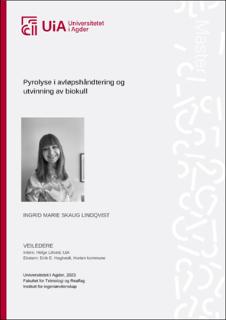| dc.contributor.advisor | Intern: Liltved, Helge | |
| dc.contributor.advisor | Ekstern: Hagtvedt, Eirik E. | |
| dc.contributor.author | Lindqvist, Ingrid Marie Skaug | |
| dc.date.accessioned | 2023-07-12T16:23:49Z | |
| dc.date.available | 2023-07-12T16:23:49Z | |
| dc.date.issued | 2023 | |
| dc.identifier | no.uia:inspera:145678485:37242735 | |
| dc.identifier.uri | https://hdl.handle.net/11250/3078339 | |
| dc.description.abstract | This thesis has investigated if pyrolysis is a sustainable solution for the treatment of sewage sludge for Horten Municipality. Separate laboratory experiments and literature research was executed to answer the research question. Sewage sludge extracted from Horten Municipality`s treatment plant has been pyrolyzed at 500°C, 700°C and 800°C. Various tests have been carried out on the biochar extracted from the pyrolysis to find out which biochar is most suited for different areas of use. The results shows that biochar extracted from sewage sludge contain important plant-available nutrients, stores and binds carbon, and binds heavy metals. These properties give the possibility that the biochar can be used in agriculture as an absorbent in ditches and green areas and as an additive in asphalt. Furthermore, the results from the laboratory study found that the biochar produced at 500°C is most suited to be used as a soil conditioner and fertilizer in agriculture or as an absorbent in ditches and green areas. UN`s sustainability goals were compared with the findings from the study. Pyrolysis of sewage sludge and biochar helps to achieve other sustainability goals that fit well under the dimensions of sustainable development. In the light of the findings, it was concluded that pyrolysis technology is a sustainable solution for treatment of sludge. | |
| dc.description.abstract | | |
| dc.language | | |
| dc.publisher | University of Agder | |
| dc.title | Pyrolyse i avløpshåndtering og utvinning av biokull | |
| dc.type | Master thesis | |
